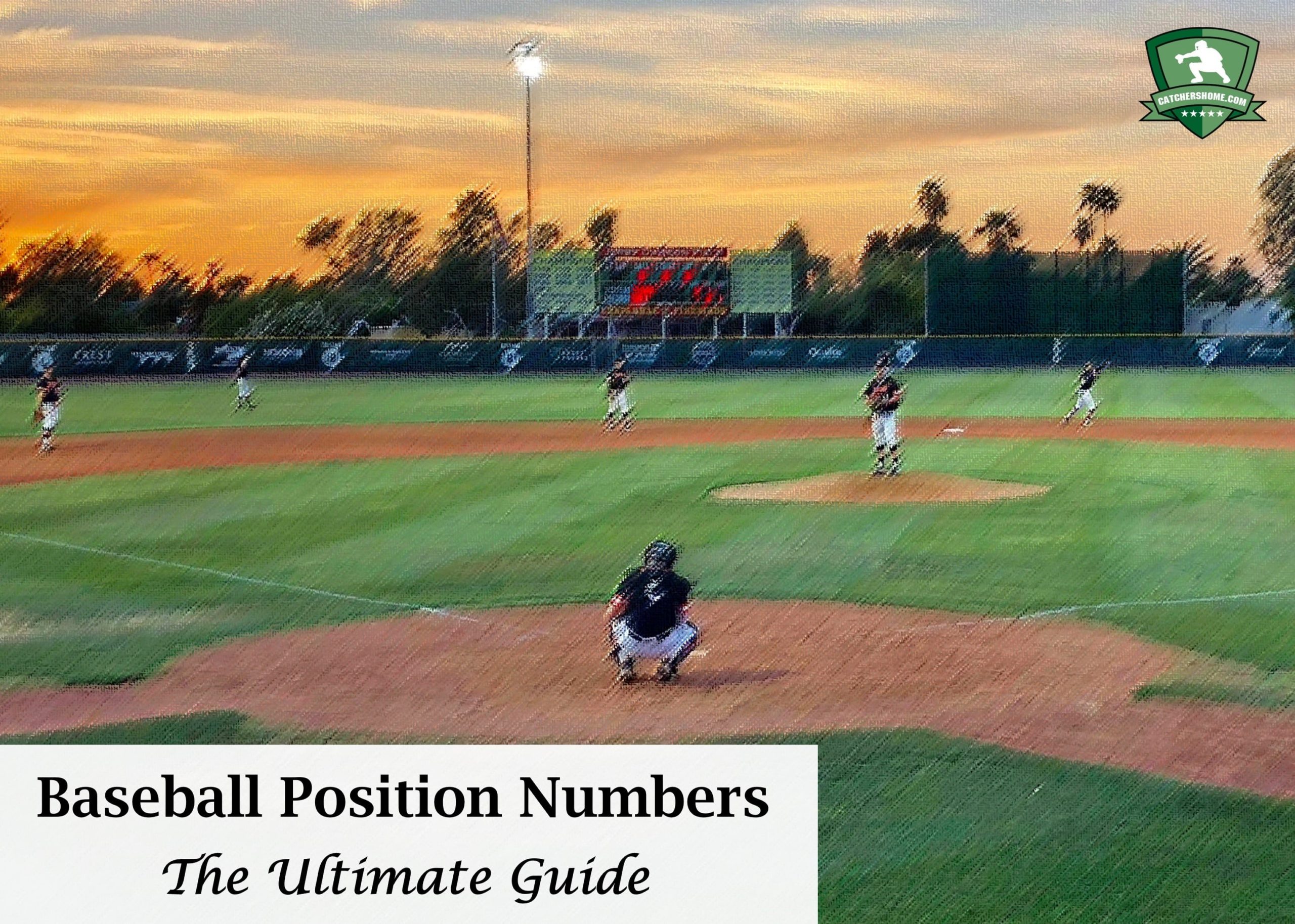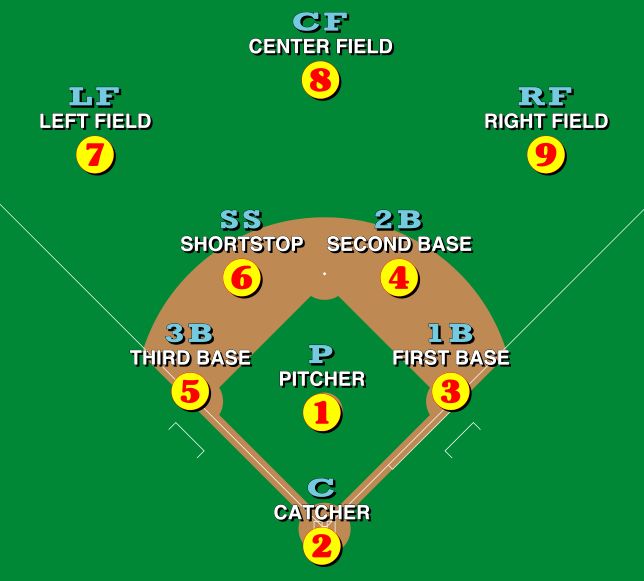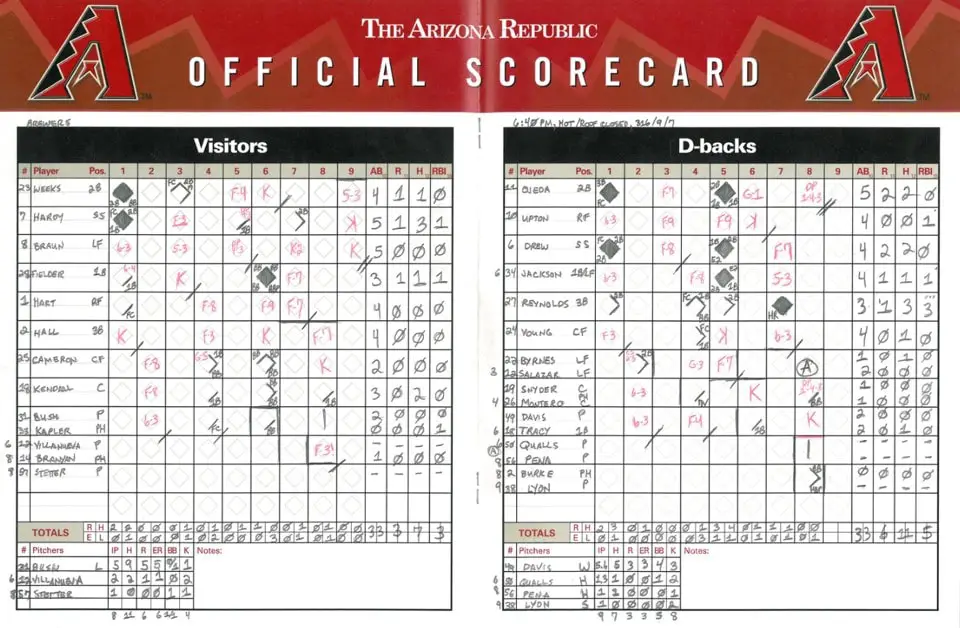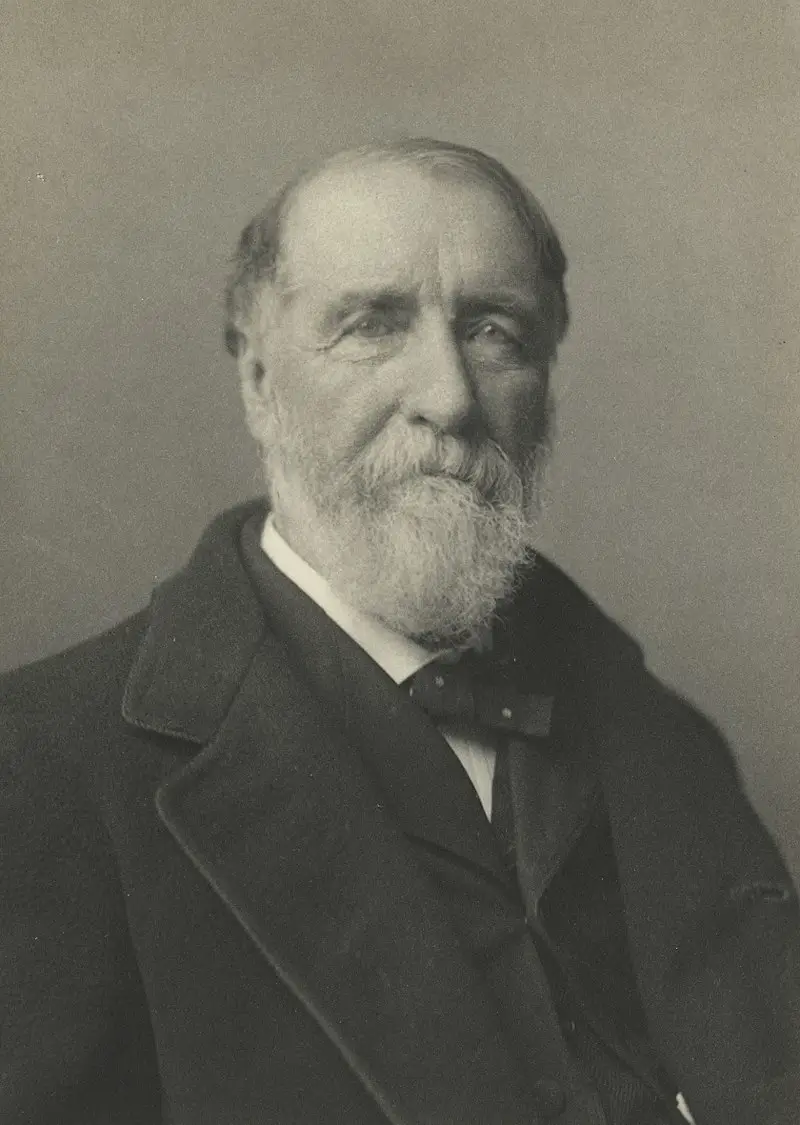No idea what baseball position numbers are? You’ve come to the right place. We’ll help you learn it quickly.
This short article will help bring you up to speed quickly on the numbers used for each position on the diamond.

The Ultimate Guide to Baseball Position Numbers
When I first started playing baseball as a kid, I have to admit that I had no idea what numbers meant when people referred to certain defensive positions.
On TV, I would hear announcers say phrases like “4-6-3” when a double play was turned. It made no sense!
Turns out, there are plenty of people that don’t know anything about baseball position numbers. This article was written to help inform folks about these numbers.
So, what are they exactly?
List of Position Numbers in Baseball
Simply put, baseball’s position numbers are most commonly used to identify position players and to record plays when keeping score.
The numbers that are designated for each position on the field are as follows:
- Pitcher is shown as 1
- Catcher is shown as 2
- First Baseman is shown as 3
- Second Baseman is shown as 4
- Third Baseman is shown as 5
- Shortstop is shown as 6
- Left Fielder is shown as 7
- Center Fielder is shown as 8
- Right Fielder is shown as 9

Why They Are Important
As mentioned, these numbers are important to know for a variety of reasons. A prime example is if you’re the person responsible for keeping the scorebook at a baseball or softball game.
As the scorekeeper, you will need to know where the ball was hit and who made each play. This is where baseball and softball’s position numbers come into play.
Often you will see the term “POS” on a scorebook which stands for “Position” – this is where you will need to list the position numbers.
These fielding numbers are also important for players to know, and even for the casual fan. For example, I’ve lost count of the number of times I’ve watched an MLB game and heard the broadcaster mention something like a “6-4-3 double play”.
What does a 6-4-3 double play mean?
It means a ground ball was hit to the Shortstop, who fielded it and threw it to the Second Baseman for the out then on to the First Baseman for the second out.
You would know exactly what the broadcaster meant if you understand this simple system of position numbers.
Basic Abbreviations for Defensive Positions
Another thing to be aware of are the symbols used for each position on the baseball or softball field. It’s pretty simply and should be easy for most folks to remember.
It’s as follows:
- P = Pitcher
- C = Catcher
- 1B = First Baseman
- 2B = Second Baseman
- SS = Shortstop
- 3B = Third Baseman
- LF = Left Fielder
- CF = Center Fielder
- RF = Right Fielder

Shorthand for Other Roles
In addition to the positions mentioned above, a number of other roles can make an appearance in some baseball or softball games. It’s important to understand these roles as well, especially if you’re keeping the scorebook.
Examples include the following:
- DH = Designated Hitter
- PR = Pinch Runner
- PH = Pinch Hitter
- SP = Starting Pitcher
- CL = Closer
Besides specific baseball and softball roles, additional shorthand is used by scorekeepers for the untold number of plays that can happen throughout a game.
For example, a K is shorthand for a strikeout. HBP is used to show for hit by pitch. WP stands for wild pitch.
All of the details involved in keeping proper score are out of the scope of this article. If you’re interested in learning more details, then we’d suggest checking out Little League Baseball’s article on this topic.
Origin of The Numbering System
The origin of this system of position numbers in baseball can be followed all the way back to the 19th century and to the work of an English writer and statistician named Henry Chadwick.
Though he was born in England, Chadwick moved to America as a teenager and quickly developed a passion for baseball. He first came to prominence as a sports writer in the New York City area, where he wrote detailed descriptions of games in his column in the mid 1800’s.

Around this same time, Chadwick created such things as the box score, batting average and the first official rule book for the game.
He is also given credit by historians for creating a variety of popular Baseball terms (e.g., “base on balls”, “error”, “cut off”, etc.).
In addition, several sources indicate that Chadwick was the person responsible for developing the system of field position numbers that is used today.
When you think about all the other innovations that he brought to the game, it makes sense that this numbering system would have also been created by Chadwick.
For his non-playing contributions, Chadwick was enshrined in Cooperstown 1938, which was just the third year of the Hall of Fame’s existence.
FAQs about Position Numbers in Baseball
Since we have now covered baseball field position numbers and shorthand used for different roles and positions, we thought it might be helpful to go over a few frequently asked questions (FAQ) about this topic.
Keep reading to these FAQs with our answers to each.
- What are fastpitch softball position numbers?
- Fastpitch softball position numbers are the same as baseball position numbers.
- Are the position numbers used in baseball the same as what are used in fastpitch softball?
- Yes, the numbering system is the same for both baseball and softball.
- What position is 6 in baseball?
- The position in baseball given the number 6 is the Shortstop.
- Why is the Shortstop listed as #6 instead of #5?
- Answer: To answer this question, we have to look back to baseball’s early history when the field configuration wasn’t the same as what it is today. In the early days, the Shortstop was responsible for covering shallow outfield. Essentially, the Shortstop back then was considered another outfielder. So, the position was given the number 6, coming after the Third Baseman. Later on when the Shortstop was moved to its current position in the infield, its original number was simply unchanged.
- Why do some softball games have 10 defensive position numbers instead of 9?
- Some softball leagues use four outfielders instead of the traditional three people in the outfield. In that case, position #10 stands for the additional outfielder. It’s also the number typically used for what a scorebook refers to as an “Extra Player”, or “EP”.
- What is the 10 position in baseball?
- You may notice that 10 is used in some scorebooks for baseball games. The 10 position stands for “Extra Player”. Alternatively, it can also refer to the Designated Hitter, or DH.
- What are the key categories for defensive positions in baseball and softball?
- There are nine positions on the field and these are often grouped into three different categories. The first group is known as the battery, and it includes the pitcher and catcher. The second group is the infield, which is made up of the First Baseman, Second Baseman, Shortstop and Third Baseman. The third group is the outfield, which contains the Left Fielder, Center Fielder and Right Fielder.
- Why is the pitcher #1 in the baseball number positions?
- We don’t have a clear answer to this one, other than to say that each play starts with the pitcher and that they (along with catchers, of course) are most actively involved in every pitch when on defense. Due to this significance in the play-by-play of each game, the pitcher is assigned as #1.
- What do the numbers mean in a double play?
- The numbers people use when discussing a double play refer to the position numbers of baseball players involved in turning the double play. Each number corresponds to a player that touched the ball in the course of a play. So a ground ball back to a pitcher that’s tossed to the shortstop at second (out one) then on to the first baseman (out two) is a 1-6-3 double play.
- The 3 outfield positions are represented by what 3 numbers in a score book?
- The 3 outfield positions are represented by the following 3 baseball position numbers: Left Fielder is 7, Center Fielder is 8 and Right Fielder is 9.
- What are the MLB position numbers?
- Major League Baseball position numbers mirror the normal baseball number positions mentioned in the article above.
- What do the positions MRP and LRP stand for?
- MRP stands for Middle Relief Pitcher while LRP stands for Long Relief Pitcher, also referred to as a long reliever. For much more detail on these two unique roles, check out our article on MRP pitchers or our one on LRP.
- What does the U mean in softball?
- Scorekeepers use a U in softball when an unassisted putout occurs. That means the fielder got the out on their own, such as when a pitcher fields a grounder and runs to first to get the out on their own.
- What does BB mean in softball and baseball?
- BB stands for base on balls. It’s the shorthand used when a batter is walked.
- What does F mean in softball?
- F stands for flyout – when a batter gets out by popping the ball up to a fielder. Usually in the scorebook a number comes after the F to indicate the position which caught it. For example, F8 means the center fielder caught the ball for the out.
Thank You for Reading!
Hopefully you found this article to be helpful to you!
If you are interested in getting in touch, then please go to the Contact Us page or simply send an email to scott (at) catchersome (dot) com. We’re always happy to hear from readers.
Thanks for stopping at Catchers Home.
Scott Perry
Scott Perry is the owner and lead author at Catchers Home. He's a former baseball player, a current coach, a husband and a Dad. He remains as passionate about baseball today as he was as a kid.

